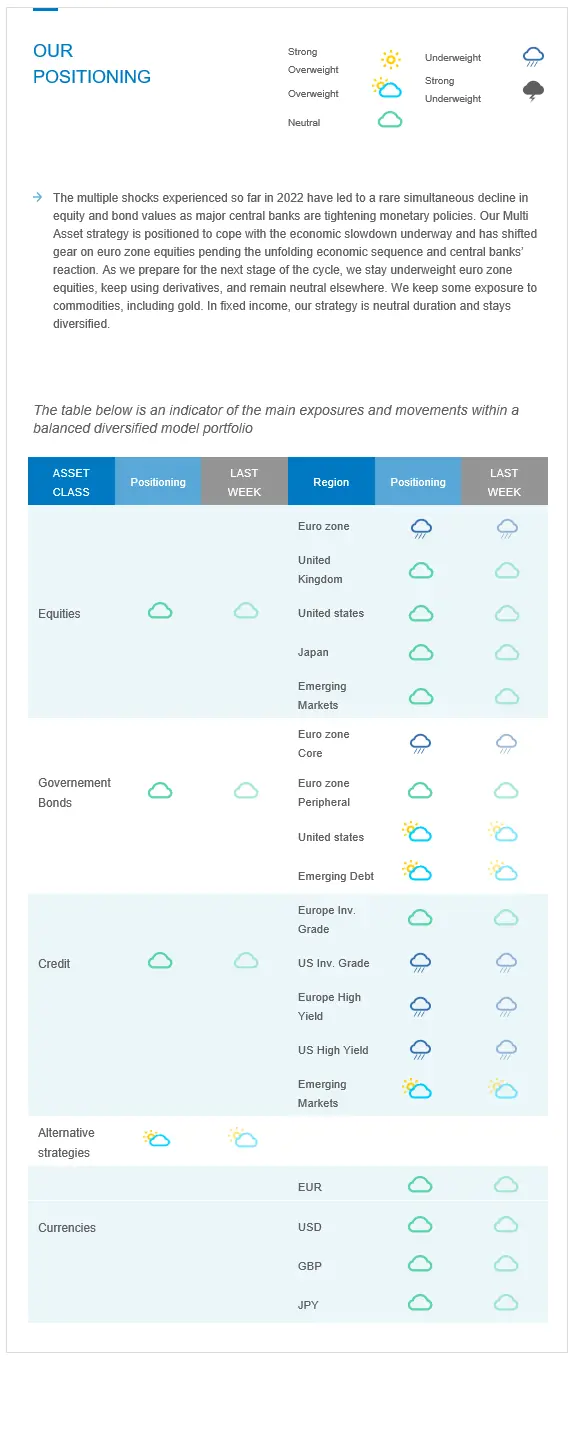Last week in a nutshell
- To mitigate the drastic reduction in gas supply, EU energy ministers approved a draft European law meant to lower demand for gas by 15% starting in August and lasting until next March. The legislation implies voluntary national steps to reduce consumption, but if that does not generate enough savings, mandatory actions in the 27-member bloc would be triggered.
- As widely expected, the FOMC raised its funds rate target range by 75bp to 2.25%-2.50%. Chair Powell indicated that another similar-sized hike could well be warranted in September but that "unusual" moves of this size should not be viewed as the norm. Data-dependent, the Committee will now make decisions on a meeting-by-meeting basis. Markets interpreted the message as dovish. Subsequently, rate hike expectations were revised down.
- The U.S. economy contracted for the second straight quarter with inflation at the root of much of the economy’s troubles. Other factors include decreases in inventories, residential and non-residential investment, and government spending. More than ever, consumer spending and businesses investing will be key. Meanwhile, in the euro zone, Q2 GDP grew by 0.5%, boosted by the upcoming tourism season.
- Earnings season continued. Big-tech earnings helped support equities, temporarily undisturbed by the latest personal consumption expenditures price index which rose by 6.8% in June, the biggest 12-month move since the 6.9% increase in January 1982.
What’s next?
- Italy will also be under the spotlight in the coming weeks with the election of a new government. Italian political instability will be a hurdle to EU financial support. The rise of far-right parties and the economic situation which depicts Italy as a debt-laden country will be key-issues to look at before the elections in September.
- Several central banks are meeting. The Bank of England’s decision is widely awaited. UK inflation is at a 40-year high. The Bank has already increased rates to 1.25% so far. The forward guidance shall again be key.
- The US job report is widely expected to see whether the labour market is becoming more balanced and growth slowing sufficiently. If the actual data come in line with expectations, it could help the Fed to continue its tightening policy but at a slower pace.
- China will publish its leading indicator figure on its manufacturing and services activities. Investors will pay attention to the first estimates of growth in the aftermath of the most recent Politburo meeting. One of the main takeaways is that the growth target of 5.5% is in question.
Investment convictions
Core scenario
- Our exposure keeps an overall broadly balanced allocation before positioning for the next stage of the cycle, whether it be a soft or a hard landing.
- While the market environment still appears constrained by deteriorating fundamentals, markets are looking to central bank announcements even if they are becoming increasingly data dependent.
- Facing multi-decade high inflation, the Fed continued its hiking cycle in July by adding further 75 bps to its funds rate and plan to pursue its tightening path thereafter. In our best-case scenario, the Fed succeeds in landing the economy. As a result, we expect the rise in the US 10Y yields to fade.
- Inflation is also at highs in the euro zone, hitting businesses, consumers, and ECB policymakers alike. The ECB announced an initial rate hike for the month of July and delivered a 50-bps hike. It also unveiled a new tool, the “Transmission Protection Instrument” (TPI). Further hikes are still expected going forward and will depend on the evolution of future economic data.
- The reasons for a balanced allocation have been called into question by the decline in Russian gas flow. Moscow announced recently a 20% cut to its gas supply to Europe. The European Union is especially vulnerable to the tug of war with Russia. The risks we previously outlined are starting to materialize and are now part of the scenario.
Risks
- Investor concerns are shifting from inflation concerns to growth concerns.
- The war in Ukraine is pushing upwards gas prices. European activity is at the mercy of flows staying open. An emergency plan, “Save gas for a safe winter”, is in progress to curb consumption and find alternative sources of supply.
- A brutal, faster-than-anticipated rate tightening - if inflationary pressures increase via a new energy shock or simply persist at current levels- could jeopardize any soft landing.
- Other countries may face the Bank of England (BoE) stagflation dilemma: Even as the growth outlook deteriorates sharply, signs of upward pressure on inflation expectations, near-term wage and price setting behaviours remain.
- The threat of COVID-19, and its variants, remain as the virus keeps evolving and spreading at various speed throughout the world.
Recent actions in the asset allocation strategy
The multiple shocks experienced so far in 2022 have led to a rare simultaneous decline in equity and bond values as major central banks are tightening monetary policies. Our Multi Asset strategy is positioned to cope with the economic slowdown underway and has shifted gear on euro zone equities pending the unfolding economic sequence and central banks’ reaction. As we prepare for the next stage of the cycle, we stay underweight euro zone equities, keep using derivatives, and remain neutral elsewhere. We keep some exposure to commodities, including gold. In fixed income, our strategy is neutral duration and stays diversified.
Cross asset strategy
- Our multi-asset strategy stays more tactical than usual and can be adapted quickly in this highly volatile context:
- Underweight euro zone equities, with a derivative strategy in place to catch the asymmetric potential. We have a preference for the Consumer Staples sector where we find pricing power.
- Neutral UK equities, resilient segments, and global exposure
- Neutral US equities, with an actively-managed derivative strategy.
- Neutral Emerging markets, because our assessment indicates an improvement, especially in China, both on the COVID-19 / lockdown and stimulus fronts during H2.
- Neutral Japanese equities, as accommodative central bank, and cyclical sector exposure act as opposite forces for investor attractiveness.
- With some exposure to commodities, including gold.
- In terms of sectors, we favour “long duration” assets, i.e. tech names, as we expect less headwinds from bond yields during H2.
- In the fixed income universe, we acknowledge downward revisions in growth, highs in inflation expectations and strong central bank rhetoric regarding the willingness to tighten and fight inflation. We are neutral duration, with a preference for US duration.
- We continue to diversify and source the carry via emerging debt.
- In our long-term thematics and trends allocation: While keeping a wide spectrum of long-term convictions, we will favour Climate Action (linked to the energy shift) and keep Health Care, Tech and Innovation, Demographic Evolution and Consumption.
- In our currency strategy, we are positive on commodity currencies:
- We are long CAD.

